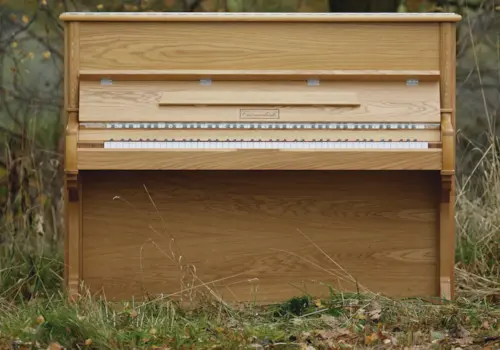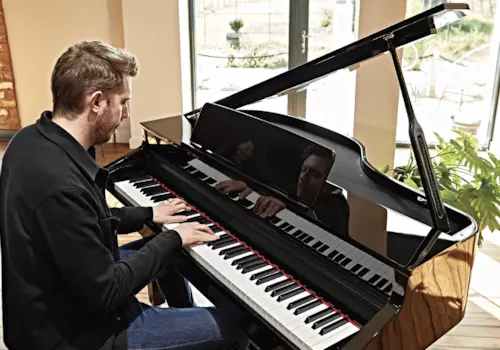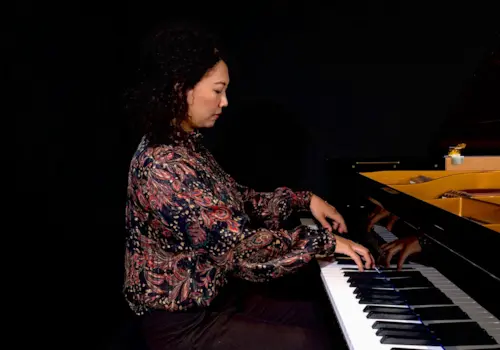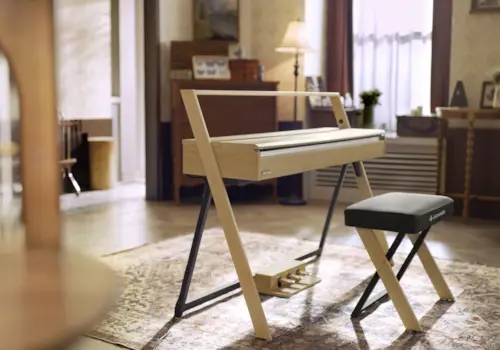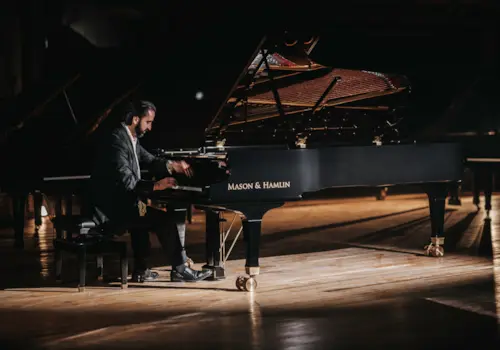22 April 2025
|
When it comes to practising the piano, many pianists believe it's all about quantity rather than quality. It's HOW you practise that will make the real difference
There is a wonderful YouTube clip of the late, great American pianist and teacher Earl Wild giving a masterclass at an American university. Wild, well into his 80S when the class was filmed, is full of invaluable tips and amusing asides. ‘You know,’ he says, stopping the student mid-performance, ‘I see so many students gazing heavenwards before they start to play anything, as if waiting for some kind of divine inspiration. What are they waiting for, I wonder? God won’t help them, I tell them. What will? Practising, of course,’ he says with a laugh.
There are very few clips of Earl Wild you YouTube these days, but we came across this one:
Learn from Earl
In many ways, Wild is quite right. But practising is just a word and, unless taught well from the beginning, very few students – whether children or adults – really seem to know instinctively how to practise. A teacher needs to convey to them the essence of good habits, hoping at some stage down the line they will become more independent. Yet many students continue to hold this notion that the more they practise, the better they will get. Some parents are convinced if their child puts in an incredible six hours a day (there are professional musicians who practise far less), their child will achieve miraculous results. But it’s about the quality of the practice, not the quantity.
Is there only one way to practise? Definitely not.
As the saying goes, there are many roads that lead to Rome. Whatever your level of ability, the basic principles are the same: always know what you are going to practise before you start; tackle each difficulty, bit by bit; separate hands first before putting together, and make sure you know the fingering.
When time is short
If time is short, and invariably it is, you want to be as economical with your practising as possible. Try to break your practising up into easily achievable chunks. Make a timetable and set out exactly what you want to do on a weekly, fortnightly or monthly basis, with goals that should be achieved at the end of each time period. Timetables are meant to be broken (!), so if you have less time one particular month, then so be it, in which case you will need to learn to be even more economical and efficient with the time you’ve got.
Easy bits last
Teachers will often see students with the same difficulties that they swear they practised and practised the week before. When asked exactly what they did at home (using some careful and diplomatic detective work), the same pattern emerges. Invariably, the student will have practised the easy bits first, often always from the beginning (which is why the opening bars of most pieces are always more fluent), and never at a suggested practice speed. The word ‘slow’ doesn’t seem to enter their vocabulary, so convinced are they that they will achieve miraculous results at 100 miles an hour. And heaven forbid they practise separate hands!
Why not make a point of downloading Graham Fitch's FREE Masterclasses eBook. Lots here to help you improve!
Make a list
Where to start? Every piece has its own inherent challenges, yet no student will have the same difficulties in playing it as another student. Before even starting to play a note of music, make a list of what you know you are going to find difficult in the piece. You might struggle with a rhythm or an ornament, or with a demanding passage of arpeggios or chords; this is apart from the musical or interpretative aspects of the piece. Aim to be as detailed as possible, and depending upon your level, itemise difficulties in order of priority and without even touching the piano. And if you are really absent-minded, make your list of the difficulties right on the score.
Once you have made your list, you can start examining all the items on it at the piano. You may well find yourself crossing things off the list pretty quickly, because the physical act of trying things out can often (but not always) make them easier. Trickier bits will undoubtedly need careful work, and this is where you need to make a timetable. A handy tip is to mark the score up in coloured pencil, sectioning things off to be practised for specific days of the week.
Deep learning
Now the proper work can begin. It’s always tempting to work on the easy sections first, but it’s far better to start with the most difficult sections first and then work backwards to the easier bits. Having the timetable in front of you will force you into the habit of ordering your time and prevent you from just playing the piece through. Whatever the problem, always practise very slowly and with separate hands. Start out by practising two bars at a time, or a musical phrase at a time, and sometimes even half a bar if the passage is especially difficult, and then building up the piece from there.
Once you can play everything correctly, increase the speed little by little, until everything works to your satisfaction. Then work through the same process hands together. Tick off the things on your list you learn to play, so that there is a clear sense of achievement. This is especially useful as a motivator for younger pupils while older pupils can always reward themselves with a cup of tea or even something stronger.
The importance of rhythm
Rhythmic practice, such as short/long and long/short rhythms can help to even out a line of quavers or semiquavers. You can also try practising in different note-groups such as playing notes in small note-groups (e.g C-D, C-D-E, C-D-E-F and so on), so you are literally disciplining the fingers and building up finger memory at the same time. This is particularly useful when you want to practise for speed, as it gives you the chance to look microscopically at the choreography of the fingers and hand. You can also record or film your playing.
Here's one of our great masterclasses on how to sharpen your rhythm, filmed at Steinway & Sons, London.
Don't look down
Try to play a passage without looking at your hands. While some younger learners might be excited by the prospect of playing without looking at their hands, many older students are horrified, as if they’ve been asked them to play a piece standing on their head! In scale playing, students can to get so bogged down with notes and fingering, but as soon as you take away the visual reference, a kind of extrasensory perception takes over and the problems seem to go away. The pupils are forced to listen very carefully to what they are doing and feel their way, thus making the music much more secure under the fingers.
Feel your way around
This sensory technique can also be used to great effect with octave passages, or where the music has large jumps or leaps. An inexperienced student will attempt to play each large distance as quickly as possible, which invariably results in missed notes, a harsh sound and an uneven feel. Trying to play the ‘outline’ of the passage, such as the bottom note of one chord to the bottom note of the next (or top note to top note) while keeping the other fingers silently resting over their respective notes, can help a great deal. It allows a player to judge the feel of a distance so much better, and eliminates (most of the time) the risk of missing a note. Piano teachers call this ‘ghost playing’, and the technique can be used for simple octave passages or thicker chord groups, patterns which are found in many of Chopin’s Nocturnes or Waltzes for example. It’s an invaluable skill to cultivate for all kinds of repertoire.
Variety is the spice of practice
Don’t stick to the same practising ideas over and over again. Practising in different ways makes it more interesting. You can even make a written note of how you practised a particular passage, so that you can apply the same technique to another piece you may study in the future. Practising the same passages in different hands, or different octave ranges can help, too. So if you have a passage for the right hand, try transposing it to the left and vice versa, or even in a different key, which helps improve your transposition skills. Remember also that if a passage works one day, it does not mean that it will work the next, so repetition and repetition with variation can help with the overall security and greater muscle memory.
Practising properly is not always self-evident, and, if you can forgive the cliché, it’s not always easy to see the wood from the trees. It is a learning curve, but when it works, and you reap the results, it is incredibly rewarding. Try to take regular breaks between practice sessions and don’t be too hard on yourself, and remember that, whether practising for exams or pleasure, the end goal should always be the same. So brush off those cobwebs, get down to business, and heed Mr Wild’s salutary words.
To summarise....
FIVE TOP PRACTICE TIPS
1. Determine what you want to achieve over a specific time period with a piece and break up your goal into achievable smaller objectives.
2. Plan out your daily practice sessions using timetables and lists. Tackle the difficult bits first and consider marking them into the score in coloured pencil.
3. Practise slowly and hands separately.
4. Build up the piece by practising smaller sections; the sections could be as small as just a few notes.
5. Be creative with your practising and think long-term.
FURTHER READING ON PRACTISING
The Art of Practising the Piano, Jeffrey Whitton (Stainer & Bell)
The Art of Piano Playing, Heinrich Neuhaus (Kahn & Averill)
Keys to the Keyboard, Andor Foldes (Oxford University Press)
Finally, join Pianist Prime and immerse yourself in a treasure trove of scores, expert insights, in-depth tutorials and captivating stories from pianists past and present...

